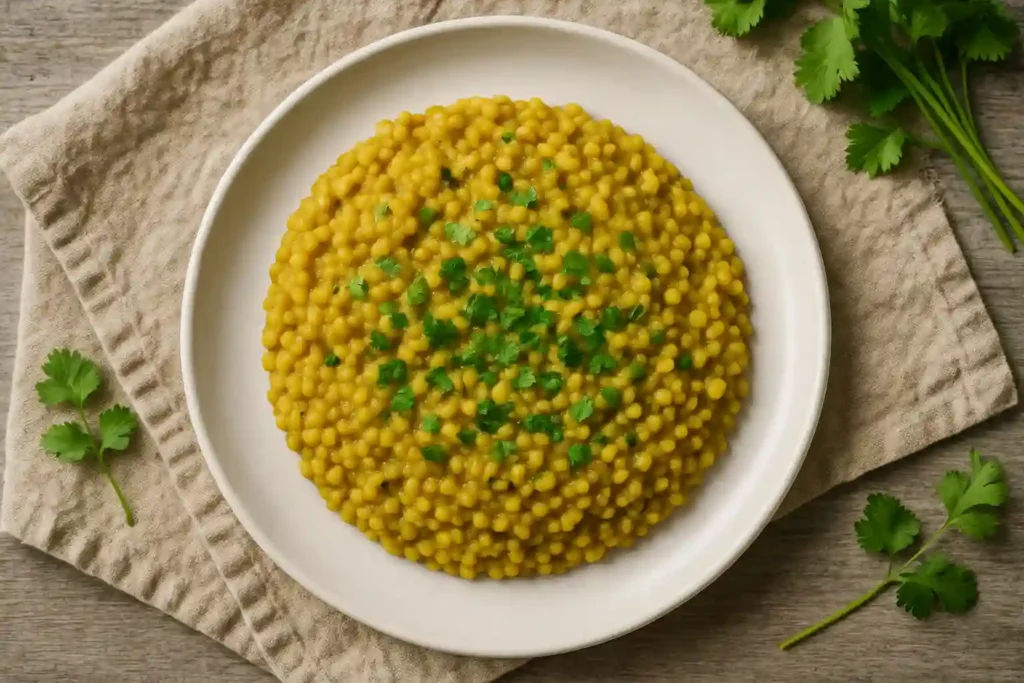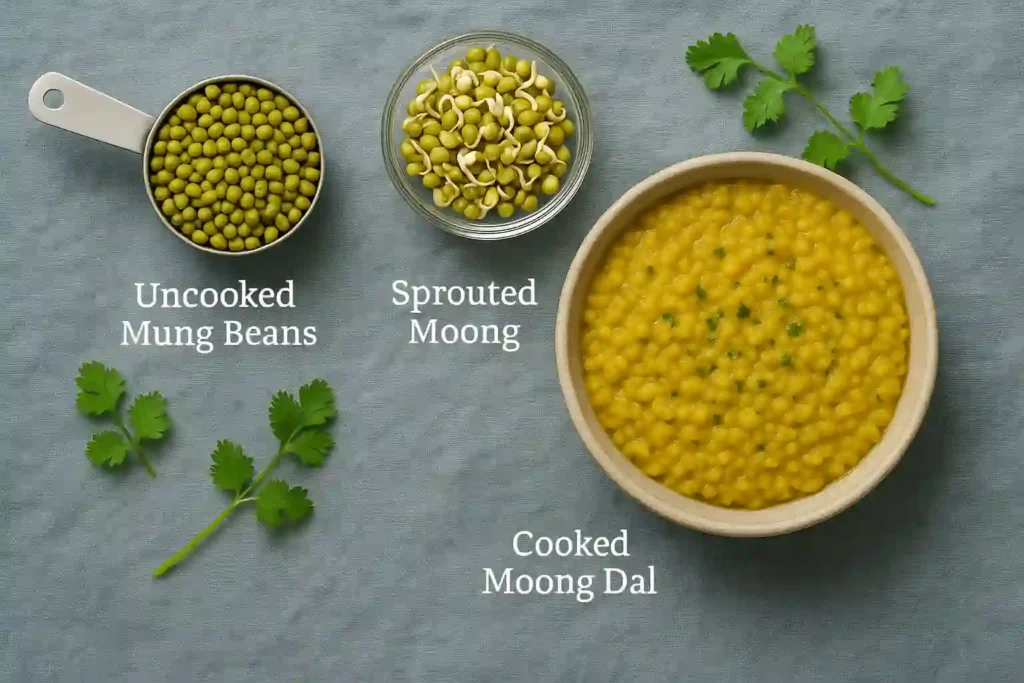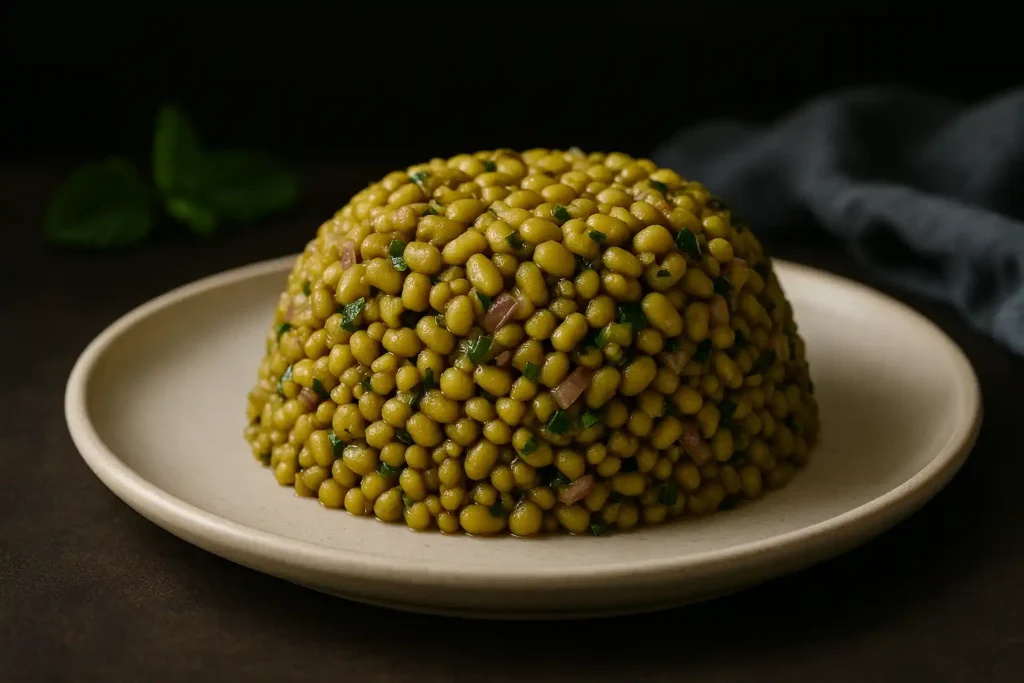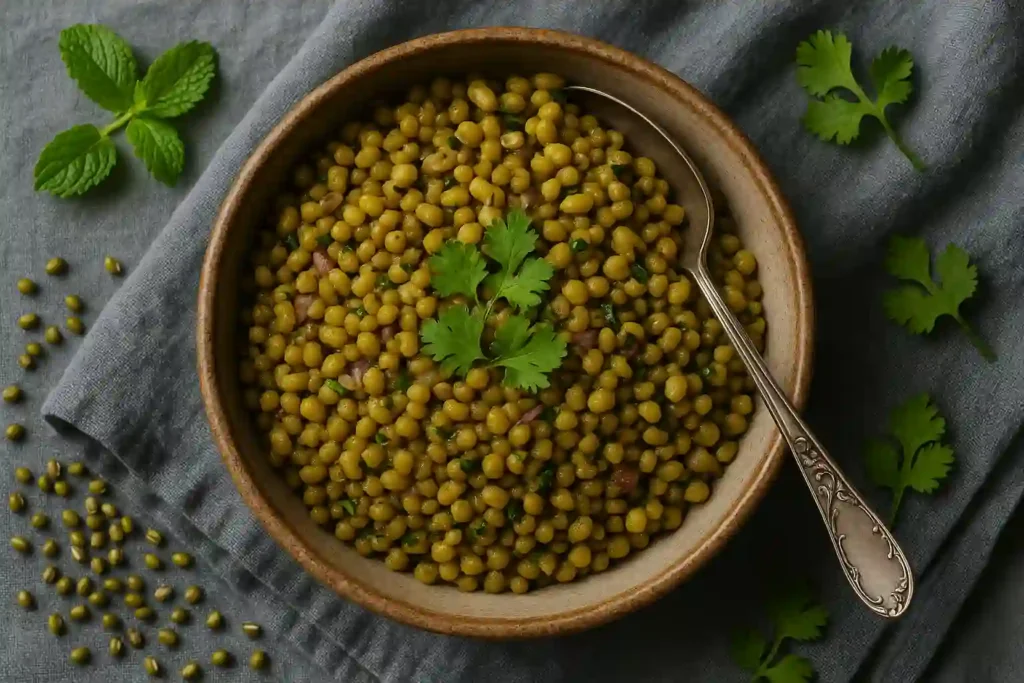Ever stood in your kitchen with a bag of moong beans and wondered, “How much protein is in 1/4th cup dry whole moong?” You’re not alone. When I first started tracking protein for my family meals, moong dal became a staple—but the math didn’t always seem clear. This article shares exactly what you can expect protein-wise in that modest scoop, why it matters, and how you can use it to build nutritious meals easily. We’ll break down cooking methods, comparisons, and real-life uses. Plus, I’ll sprinkle in some personal favorites and internal links from Taste Our Dish to inspire your cooking journey.

Table of Contents
Table of Contents
How Much Protein Is in 1/4th Cup Dry Whole Moong?
Why I Turn to Moong When I Need Real Protein Power
One chilly evening, with rain tapping at the windows and my pantry looking pretty bare, I grabbed a small jar of moong beans and thought, “Let’s make this work.” I measured out exactly 1/4th cup dry whole moong, soaked it quickly, and tossed it into the pressure cooker with garlic, cumin, and whatever veggies I had on hand. What came out was a comforting, creamy dal—and I couldn’t believe how filling it was. That was the night I started paying attention to the real protein power behind these humble little beans.
Since then, I’ve made them part of our weekly rotation. Whether it’s a hearty dal or a moong-based veggie bowl, I’ve learned that 1/4th cup dry whole moong protein isn’t just a number—it’s the foundation for countless healthy meals. I even use it as a base in creative recipes like this cottage cheese pizza bowl, where it blends perfectly into the sauce without overpowering the flavors.
The Truth About 1/4th Cup Dry Whole Moong Protein

So, what’s in that 1/4th cup dry whole moong? On average, you’re looking at about 12 grams of protein. That’s a major win for such a small amount. Once cooked, the volume increases as the beans absorb water, but the total protein stays nearly the same—it just gets spread out. So while a cooked version of that same amount might measure closer to 3.5 grams per 1/4 cup, remember, you’re still getting the full benefit of the 1/4th cup dry whole moong protein you started with.
This measurement matters when you’re building meals around plant-based proteins. For example, pairing moong with something like protein bagels or even a side of scrambled tofu boosts your protein total for the meal in a smart, satisfying way.
How I Sneak in 1/4th Cup Dry Whole Moong Protein Throughout the Week
I’ve used moong in all kinds of dishes—soups, curries, even rolled into veggie patties. Sometimes, I’ll add it to my vegan oatmeal cookies for a nutty texture and an unexpected protein kick. The reason I love 1/4th cup dry whole moong protein as a base is because it’s not just nutritious—it’s neutral. It takes on the flavors of the dish without fighting them.
There’s something deeply comforting about knowing that one tiny scoop of dry moong beans can support a whole meal. It’s affordable, shelf-stable, and totally underrated. Whether you’re new to moong or you’ve grown up with it like I did, this little legume deserves a fresh spotlight.
Cooking Matters – What Happens to Protein When Moong Is Cooked or Sprouted?
Why Cooking Changes Everything for 1/4th Cup Dry Whole Moong Protein

If you’re measuring protein by the scoop, the way you prepare moong really matters. When I first started using moong to hit my protein goals, I assumed raw, cooked, and sprouted had the same impact. But 1/4th cup dry whole moong protein changes depending on how you cook it. Soaking causes it to swell, cooking softens the texture, and sprouting? That brings in a whole new set of benefits.
Raw and dry, 1/4th cup whole moong holds about 12 grams of protein. But after you soak and boil it, you get more volume but less protein per bite. The original 12 grams of protein is still there—it’s just spread out in a larger bowl. That’s why cooked moong may show around 3–4 grams per 1/4 cup, but don’t be fooled—the 1/4th cup dry whole moong protein hasn’t disappeared, it’s just more waterlogged.
For quick weeknights, I love throwing cooked moong into dishes like my keto breakfast bowl. It blends beautifully with roasted veggies and a soft-boiled egg. You still get all that satisfying 1/4th cup dry whole moong protein without the effort of tracking extra steps.
Sprouted vs. Cooked: Which Has More Protein?
Here’s where things get interesting. When you sprout moong, the nutrient profile shifts. The fiber increases, digestibility improves, and while the protein per gram may slightly drop, the body absorbs it better. A cup of sprouted moong has around 7–8 grams of protein. That’s not bad when you consider how light and fresh it tastes—especially tossed into something like this fresh garbanzo bean salad. If you’re eating clean, sprouted moong is an easy way to support your nutrition goals.
Now let’s talk real life. I usually soak 1/4 cup dry whole moong overnight, then split it in two. Half goes into a curry for dinner, and the rest I let sprout over the next couple of days. That way, I get both benefits—cooked softness and sprouted crunch. No waste. Full nutrition.
1/4th cup dry whole moong protein gives you a reliable 12-gram boost, whether you simmer it in a stew or stir it into a salad. The format might change, but the protein value remains consistent—and that’s exactly why it’s a star ingredient in my weekly meal prep.
How 1/4th Cup Dry Whole Moong Protein Stacks Up Against Other Lentils
Is Moong Really Better Than Other Lentils for Protein?
I’ve tried nearly every type of lentil—masoor, chana, toor, you name it. But when I started tracking actual numbers, 1/4th cup dry whole moong protein stood out. It consistently gave me about 12 grams of protein, while others varied more. Masoor dal (red lentils) offers about 9 grams per 1/4 cup dry, and chana dal can get close to 11 grams—but moong holds steady, cooks faster, and is easier on digestion.
What I also love is how versatile moong is compared to other lentils. It’s light enough to add to a fluffy banana cottage cheese pancake mix or tuck into savory snacks. I rarely do that with heavier dals like toor.
If you’re choosing your lentils based on nutrition and flexibility, 1/4th cup dry whole moong protein is one of the best investments in your pantry. You can even blend it into patties, stir it into breakfast bowls, or use it as a protein filler in wraps and flatbreads.
What Most People Get Wrong About 1/4th Cup Dry Whole Moong Protein
Let’s clear up some confusion. First, 1/4th cup dry whole moong protein refers to the uncooked quantity. Many people assume that once moong is boiled or sprouted, the protein content increases or decreases drastically. In reality, the protein content stays about the same—it’s just measured differently after cooking because the volume changes with water absorption.
Also, don’t mistake low calorie for low protein. Some folks pass over moong because it feels “light.” But 1/4th cup dry whole moong protein delivers more than some meat-based items in terms of quality and digestibility. It’s also naturally fat-free, making it great for heart-friendly dishes like my air fryer sweet potato cubes with moong salad.
Another myth? That moong is bland. Trust me—add just cumin, garlic, lemon, and a pinch of chili, and you’ve got a bold, flavorful base that complements just about anything.
If you’ve ever overlooked 1/4th cup dry whole moong protein thinking it’s too humble, now’s the time to bring it center stage in your cooking.
FAQ
How much protein is in a cup of uncooked moong dal?
A full cup of uncooked moong dal holds around 47–50 grams of protein. That’s why 1/4th cup dry whole moong protein gives you about 12 grams—it’s exactly one-fourth of the bulk and one-fourth of the benefit. It’s an efficient source of plant-based protein that easily fits into everyday meals.
How much protein is in 1/4 cup cooked lentils?
Once lentils are cooked, their volume increases due to water absorption. So while 1/4 cup dry moong has roughly 12 grams of protein, 1/4 cup of cooked moong contains about 3.5 to 4 grams. The key is that cooked volume increases, but the total protein remains based on the dry measure.
How much protein is in 1 cup of sprouted moong?
Sprouted moong is lighter, fresher, and easier to digest—but its protein per volume is slightly reduced. A 1-cup serving of sprouted moong gives about 7–8 grams of protein. Still, the benefits of better absorption and higher fiber make it a great complement to other whole food proteins like those in our marry me chickpeas recipe.
How much protein is in 1 cup of cooked mung beans?
Fully cooked mung beans offer around 14–15 grams of protein per cup. So when you start from 1/4th cup dry whole moong protein and cook it fully, that same portion becomes approximately one cup in volume and retains its 12–14 grams, depending on density and soak time.
Final Thoughts: What I’ve Learned From 1/4th Cup Dry Whole Moong Protein

Every time I scoop out that 1/4th cup of dry moong beans, I know I’m setting myself up for a meal that’s affordable, filling, and nutrient-rich. It’s become a quiet kitchen habit—one that brings comfort and strength to my family’s meals. Whether I’m stirring it into a weekday curry or blending it into a weekend snack, that little scoop offers more than just numbers. It gives me peace of mind.
If you’re just starting your plant-based journey or trying to add more protein to your plate, you don’t need fancy powders or pricey ingredients. You just need that humble 1/4th cup dry whole moong protein—and maybe a few vegan oatmeal cookies on the side.
Trust it. Use it. Enjoy it.
for more recipes follow me in facebook
Print
1/4th Cup Dry Whole Moong Protein: The Surprising Truth You Need to Know
- Total Time: 8 hrs 25 mins
- Yield: 1 cup cooked
- Diet: Vegetarian
Description
Understand how 1/4th cup dry whole moong protein transforms through cooking and sprouting, with simple prep steps and everyday uses.
Ingredients
1/4 cup dry whole moong beans
Water for soaking or boiling
1/4 tsp cumin seeds
1 garlic clove, minced
Salt to taste
Fresh lemon juice (optional)
Fresh chopped cilantro
Instructions
1. Rinse 1/4 cup dry whole moong thoroughly under cold water.
2. Soak the moong beans in water for 6–8 hours or overnight.
3. To cook: Drain and boil with 1 cup fresh water for 20–25 minutes until soft.
4. To sprout: Drain, then wrap soaked moong in a damp cloth and keep in a warm place for 24–36 hours.
5. Optional: Sauté garlic and cumin in a pan, add cooked moong and salt, then stir until warm.
6. Top with cilantro and a splash of lemon juice before serving.
Notes
1/4 cup dry moong contains approximately 12g protein.
Cooked moong expands in volume but retains the same total protein.
Sprouted moong is slightly lower in protein by weight but easier to digest.
- Prep Time: 8 hours (soaking)
- Cook Time: 25 minutes
- Method: Boiling, Sprouting
- Cuisine: Indian
Nutrition
- Serving Size: 1 cup cooked
- Calories: 105
- Sugar: 1g
- Sodium: 5mg
- Fat: 0.5g
- Saturated Fat: 0g
- Unsaturated Fat: 0.5g
- Trans Fat: 0g
- Carbohydrates: 18g
- Fiber: 6g
- Protein: 12g
- Cholesterol: 0mg


